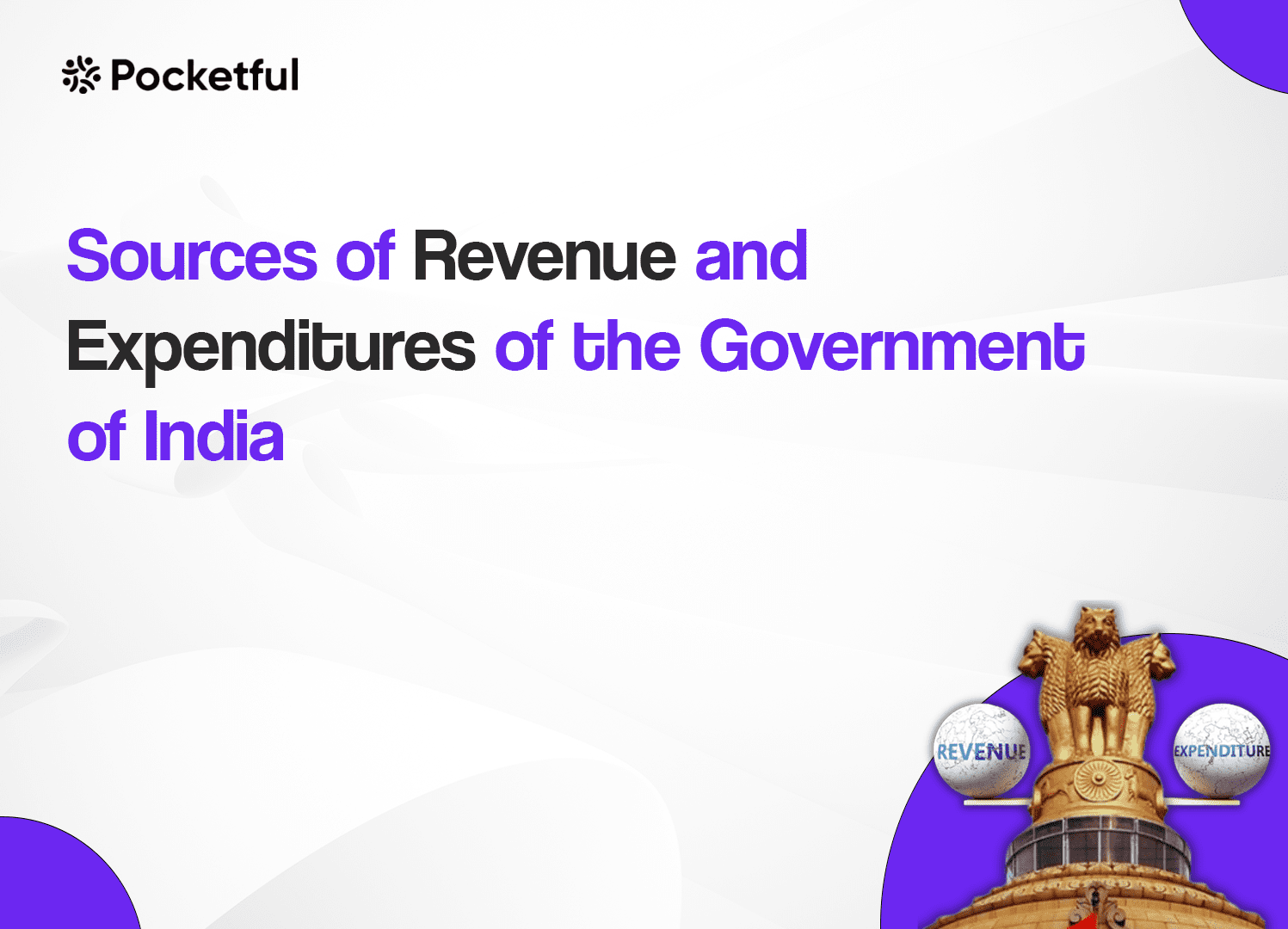| Type | Description | Contributor | Date |
|---|---|---|---|
| Post created | Pocketful Team | Jun-28-24 | |
| Keyword update | Nisha | Feb-25-25 |

- Blog
- government revenue expenditures
Sources of Revenue and Expenditures of the Government of India

We put in a lot of effort to make money, but a significant amount is taken in taxes each year, which not many know how the government uses to carry out its mandate.
This blog will provide you with a thorough description of the government’s funding sources and expenditures.
Surplus and Deficit
The government gets money from various sources and uses it for the good of the people. In the situation of a fiscal deficit, its expenses exceed its income and in case of a surplus, its income exceeds its expenditures.
Sources of Government Revenue

There are several categories through which the government’s revenue streams can be separated:
Direct Tax
This tax is generally levied on the income of individual or corporate houses. The liability to pay this tax cannot be shifted to anyone else. The tax is usually based on income or earnings.
The various sources of government revenue through direct taxes are as follows-
- Income Tax: This tax is imposed on the individual’s income, which can come from various sources depending on the person, including earnings, salaries, rent, and business profits. Income tax is one of the main sources of government funding. The income tax slab is used as the basis for calculation.
- Corporate Tax: This applies to corporate houses based on their earnings in a specific year. This tax heavily affects the country’s long-term growth prospects as a low corporate tax would invite more companies into the country, while a high corporate tax would repel them.
- Capital Gain Tax: This tax is levied on the profit individuals or companies earn on selling capital assets like equity, debt, real estate, etc.
- Property Tax: This is levied on property owned by an individual and calculated based on its value and area.
Indirect Tax
The final buyer of products and services is ultimately responsible for paying taxes under this source of government funding. The price of the goods usually includes this tax. The following are the different indirect tax sources:
- GST, or Goods and Service Tax: It is a tax imposed when goods and services are sold. It was implemented in 2017 to replace several levies with one unified tax.
- Custom Duty: Importers of goods are liable to pay this tax whenever they import goods from other countries.
- Excise Duty: The government of India has majorly removed this tax but it is still levied on various goods such as petrol and diesel.
Non-Tax Revenue
The non-tax revenue sources of the government are mentioned below:
- Interest receipt: The government receives interest on investments made in public sector undertakings; this includes earnings from dividends.
- Petroleum License: This source includes revenue from petroleum licenses given to companies; it generally contains royalties or profit shares generated from oil exploration.
- Communication Fees: This includes the license fees paid by Telecom companies to the Department of Telecommunication.
Now, let’s understand how the government uses this revenue.
Read Also: What is Non-Tax Revenue – Sources and Components
Government Expenditure

The expenditure of government can be categorized into 2 broad parts:
Capital Expenditure
This investment is made to improve infrastructure, increase economic activity, and produce assets. The government spends money on capital projects in the following ways:
- Developing roadways, railways, and airports.
- Spending on defense equipment, such as purchasing weapons and other military equipment.
- The government infuses capital into various public sector companies to assist with sustenance.
- The government provides loans to various state and union territories.
Revenue Expenditure
These costs don’t produce any assets. They are seen as regular outlays made by the government for the regular operation of the economy and government. The government spends on the following areas:
- Interest on the debt owned by the government.
- Salaries of government employees.
- Additional services provided by the government such as ration, subsidies, etc.
- Providing pensions to retired employees.
Read Also: Budget 2024: Explainer On Changes In SIP Taxation
Conclusion
Though taxes are always seen as a burden, they help stimulate economic growth in the long run. Without their presence, it would be impossible to run the economy. Hence, it is also your responsibility as a taxpayer to know exactly how your taxes will be utilized to build the nation’s infrastructure, healthcare system, and educational system.
Frequently Asked Questions (FAQs)
How does the government earn money?
Government-imposed direct and indirect taxes generate the largest portion of revenue. They originate from income tax, corporate tax, and GST.
What is the fiscal deficit in the economy?
Fiscal deficit is the term used to describe the situation in which the government’s revenue is less than its outlays.
How does a government spend their money?
The government uses its funds for public welfare programs and providing basic services, like healthcare and education, to its residents. In addition, the government spends its funds to settle debt from earlier borrowing periods.
What is the purpose of the government budget?
The major objective of the government’s preparation of a budget is to allocate the available resources in the best possible manner to every sector and develop the economy.
What are the items included in the government’s revenue expenditure?
The government’s revenue expenditure includes payment of salaries of government employees, payment of pensions, and interest payment on the borrowings made by the government.
Disclaimer
The securities, funds, and strategies discussed in this blog are provided for informational purposes only. They do not represent endorsements or recommendations. Investors should conduct their own research and seek professional advice before making any investment decisions.